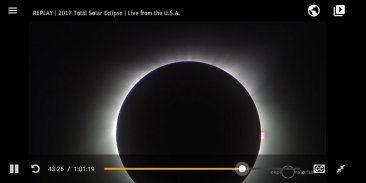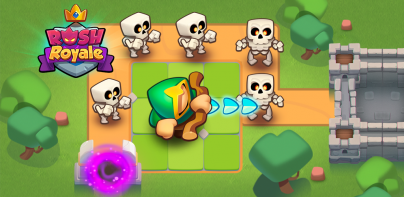










Total Solar Eclipse

Beschreibung von Total Solar Eclipse
The Exploratorium, a hands-on museum of science, art, and human perception in San Francisco, California, brings you live images of the sun during the total solar eclipses occurring on July 2, 2019 and December 14, 2020. On July 2, 2019, our team will aim telescopes at the eclipse from the National Science Foundation's Cerro Tololo Observatory in Chile to capture the event and livestream it to the world via our 2018 Webby Award-winning app.
This free app allows you to view three simultaneous video streams: 1) LIVE coverage hosted by Exploratorium educators and NASA scientists, 2) LIVE coverage in Spanish hosted by Exploratorium educators, and 3) a non-narrated, two and a half hour live telescope view of the full eclipse.
• Explore the path of totality of the 2019 eclipse and the 2020 eclipse with interactive maps and see the level of total eclipse you can observe from your location.
• Share livestream and past expedition videos.
• Follow the conversation on Twitter using #eclipse2019, #eclipse2020, #solareclipse, and #totalsolareclipse in the app's Twitter View and share your tweets about the eclipse.
• Watch and share videos that explain what an eclipse is and how to view an eclipse safely.
• Watch and share videos and explore maps from past Exploratorium eclipse expeditions including the 2017 eclipse that crossed the U.S.A. and the 2016 solar eclipse from Micronesia.
• Receive notifications about the eclipse.
When to Watch
The app displays viewing times for each live stream adjusted to your device’s time zone. Live stream start times in PDT / EDT / UTC are:
Live Coverage of the Eclipse / Cobertura en vivo en español
PDT: July 2, 2019 1:00 p.m.
EDT: July 2 2019 4:00 p.m.
UTC: July 2, 2019 20:00
Telescope View from Chile
PDT: July 2, 2019 12:23 p.m.
EDT: July 2, 2019 3:23 p.m.
UTC: July 2, 2019 19:23
Video Data Usage
We strongly recommend enabling WiFi on your device when viewing videos. Streaming videos can consume a large amount of data transfer, so please keep that in mind to avoid data overage charges from your mobile carrier. Under Mobile Network Data Usage on the Settings screen, choose “Play video only when connected to WiFi” to allow video play while on WiFi only.
Permissions
This app requires the following permissions:
Internet Access to access all app content
WiFi Network to determine if you're connected to a WiFi network
Location to map your location on the eclipse path
Notification to send you updates about eclipse livestream viewing
Calendar to add an event to your calendar about eclipse livestreams
The eclipse livestream and app is made possible through a generous grant from NASA. This material is based upon work supported by the National Aeronautics and Space Administration under Grant No. NNX16AB96A issued through the Science Education Mission Directorate. Any opinions, findings, and conclusions or recommendations expressed in this material are those of the author and do not necessarily reflect the views of the National Aeronautics and Space Administration.
Das Exploratorium, ein praktisches Museum für Wissenschaft, Kunst und menschliche Wahrnehmung in San Francisco, Kalifornien, bietet Ihnen Live-Bilder der Sonne während der totalen Sonnenfinsternisse am 2. Juli 2019 und am 14. Dezember 2020. Am 2. Juli 2019 wird unser Team Teleskope auf die Sonnenfinsternis des Cerro Tololo-Observatoriums der National Science Foundation in Chile richten, um das Ereignis einzufangen und über unsere mit dem Webby Award 2018 ausgezeichnete App in die Welt zu übertragen.
Mit dieser kostenlosen App können Sie drei Videostreams gleichzeitig anzeigen: 1) LIVE-Berichterstattung von Exploratorium-Pädagogen und NASA-Wissenschaftlern, 2) LIVE-Berichterstattung auf Spanisch von Exploratorium-Pädagogen und 3) ein nicht kommentiertes, zweieinhalbstündiges Live-Teleskop Blick auf die volle Sonnenfinsternis.
• Erkunden Sie den Weg der Totalität der Sonnenfinsternis 2019 und der Sonnenfinsternis 2020 mit interaktiven Karten und sehen Sie, welchen Grad der totalen Sonnenfinsternis Sie von Ihrem Standort aus beobachten können.
• Teile Livestream- und frühere Expeditionsvideos.
• Verfolgen Sie die Konversation auf Twitter mit # eclipse2019, # eclipse2020, #solareclipse und #totalsolareclipse in der Twitter-Ansicht der App und teilen Sie Ihre Tweets über die Eclipse.
• Sehen Sie sich Videos an, in denen erklärt wird, was eine Sonnenfinsternis ist und wie Sie eine Sonnenfinsternis sicher anzeigen.
• Sehen Sie sich Videos an, tauschen Sie sie aus und erkunden Sie Karten vergangener Exploratorium-Eclipse-Expeditionen, einschließlich der Eclipse 2017, die die USA überquerte, und der Sonnenfinsternis 2016 aus Mikronesien.
• Erhalten Sie Benachrichtigungen über die Sonnenfinsternis.
Wann zu sehen
Die App zeigt die Anzeigezeiten für jeden Live-Stream an, der an die Zeitzone Ihres Geräts angepasst ist. Die Startzeiten für den Live-Stream in PDT / EDT / UTC sind:
Live-Berichterstattung über die Finsternis / Cobertura en vivo en español
PDT: 2. Juli 2019, 13:00 Uhr
EDT: 2. Juli 2019, 16:00 Uhr
UTC: 2. Juli 2019, 20:00 Uhr
Teleskopansicht von Chile
PDT: 2. Juli 2019, 12:23 Uhr
EDT: 2. Juli 2019, 15:23 Uhr
UTC: 2. Juli 2019, 19:23 Uhr
Videodatennutzung
Wir empfehlen dringend, WLAN auf Ihrem Gerät zu aktivieren, wenn Sie Videos anzeigen. Das Streamen von Videos kann einen hohen Datenübertragungsaufwand verursachen. Beachten Sie dies, um Gebühren für Datenüberschreitungen von Ihrem Mobilfunkanbieter zu vermeiden. Wählen Sie auf dem Bildschirm "Einstellungen" unter "Datennutzung für Mobilfunknetze" die Option "Nur Videos abspielen, wenn eine Verbindung zu WLAN besteht", um die Videowiedergabe nur über WLAN zuzulassen.
Berechtigungen
Diese App erfordert die folgenden Berechtigungen:
Internetzugang, um auf alle App-Inhalte zuzugreifen
WiFi-Netzwerk, um festzustellen, ob Sie mit einem WiFi-Netzwerk verbunden sind
Standort, um Ihren Standort auf dem Eclipse-Pfad abzubilden
Benachrichtigung, um Ihnen Updates zur Anzeige von Eclipse-Livestreams zu senden
Kalender, um Ihrem Kalender ein Ereignis über Eclipse-Livestreams hinzuzufügen
Der Eclipse-Livestream und die Eclipse-App werden durch ein großzügiges Stipendium der NASA ermöglicht. Dieses Material basiert auf Arbeiten, die von der National Aeronautics and Space Administration unter der Grant-Nr. NNX16AB96A, herausgegeben von der Science Education Mission Directorate, unterstützt werden. Alle Meinungen, Erkenntnisse und Schlussfolgerungen oder Empfehlungen in diesem Material sind die des Autors und spiegeln nicht unbedingt die Ansichten der National Aeronautics and Space Administration wider.


























